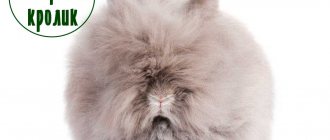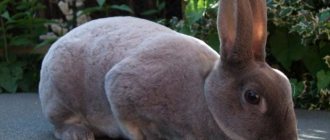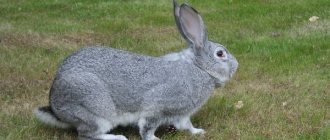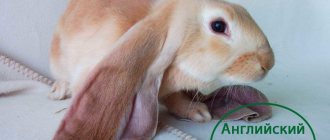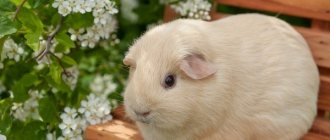Dwarf rabbits are becoming increasingly popular among pet lovers. Smart animals have a friendly character and are easy to care for. The colored rabbit is one of the smallest representatives of its kind and can be kept in a small cage. A variety of animal coat color options allow you to choose a pet to suit every taste.
Description and standards
According to the current breed standard, the weight of an adult animal cannot exceed 1250 g. For home keeping without the purpose of breeding, the permissible weight of an adult is 1.5 kg.
Body Features:
- the body of the animal is short, tightly built;
- tarsi short, well pubescent;
- the head is round, small, set on a short neck;
- The ears are rounded, no more than 5.5 cm long, straight, pressed to each other.
The eyes are large, dark, expressive. In appearance, the rodent resembles a cute plush toy with short thick fur.
The short-haired dwarf rabbit can have any color characteristic of other breeds. The following colors are popular and loved:
- Havana, luxury;
- Russian (ermine), Siamese;
- fiery black, chocolate;
- blue marder;
- squirrel;
- silver, blue, fawn;
- piebald, butterfly.
In colored rabbits, pure white coat color is rare and is highly valued by animal lovers.
History of the breed
The colored dwarf rabbit breed was bred by the German rabbit breeder Hoffmann back in 1938. To obtain it, he crossed an outbred rabbit with the red-eyed Hermelin. Two decades later, at one of the exhibitions in Germany, 24 pets of a new breed were presented, with different colors of blue, Siamese, black, gray, marder, etc.
Hermelin is one of the progenitors of colored dwarf rabbits.
The European breed standard was published in 1992, and 5 years later a modern standard was released with changes made (for example, the minimum allowable weight was increased from 0.6 kg to 1 kg ).
Behavioral characteristics
Thanks to targeted breeding for home keeping and close contact with humans, animals have a calm and docile character. During the selection process, aggressive individuals were discarded.
If you interact and play with your pet every day, and tame it gently and patiently, the colored rabbit will quickly become tame and learn to perform simple funny tricks.
The owner needs to remember that the rodent is curious and shy. If frightened, your pet may bite or scratch with its hind legs. The animal must be protected from stress.
Conditions of detention
A baby rabbit purchased at a pet store or from a breeder is placed in a cage measuring 60 by 80 cm. You can purchase a more spacious house or build an enclosure. A pet living in a small home must be allowed to run around.
The cage is placed in a quiet place, away from drafts and radiators. The rabbit house should not be exposed to direct sunlight. Comfortable temperature is 20–22 degrees; colored rabbits do not tolerate heat well.
A vacuum automatic drinker and feeders for vegetables and grain are hung in the cage. It is convenient to place the hay in a special wire ball, from where the rabbit pulls it out in small bunches. Some owners put a tray in the cage where the pet goes to the toilet.
The cage is cleaned weekly using plain, unscented soap as a detergent.
Animals of the colored dwarf breed are not bathed. Once a month, wipe the inside of the ears with a damp cloth. During the molting period, it is necessary to comb your pet with a brush.
Colored dwarf reviews from owners
I wouldn’t have gotten a rabbit myself, I wouldn’t have even thought about it, but my brother gave me this little miracle. At first I was afraid that they wouldn’t get along with the cat, but to my surprise they have been living together for three months now. It is easy to feed the rabbit hay, food, carrots, apples, he loves everything. She even loves cabbage, but I read that it’s better not to give it.
Despite the presence of disadvantages (he chews plants, wooden furniture and wallpaper, I have not yet been able to wean him off), the rabbit still became my favorite. He goes to the toilet in a designated place, but sometimes he manages to shit himself somewhere in the corner. Therefore, I only let him out of the cage when I can keep an eye on him. Anastasia
I was given a rabbit for New Year, about 5 years ago. Then he was tiny, or rather she was a white, beautiful girl. Even then you couldn’t get bored with her; she was active, playful, curious and very nimble. But a coward is afraid of strangers. There were no problems with litter box training; the principle is similar to training cats.
Her diet varies; when I have time, I buy ingredients for food at the market, and when I don’t, I buy ready-made food from the pet store. For greens, she loves green salad and carrots. He never refuses hay either. In addition to feeding, it is important to monitor the water; now my little rabbit drinks a whole water bottle in a day. When I'm at home she walks freely around the apartment, at other times she's locked in a cage.
Rabbits of this breed are playful, mine is definitely so. But we must remember about sharp teeth and claws; if you pester her when she doesn’t want to, you can get back in the form of scratches. Rabbits also like to chew wires, papers and things, so all this should be in inaccessible places. And lastly, these are not the quietest pets, if you are sensitive to noise at night, it is probably better not to get a rabbit. Svetlana
Feeding
For domestic rabbits, special feed mixtures are purchased, which include:
- extruded grain of oats, barley, corn, wheat;
- sunflower seed, flax seed;
- pieces of dried carrots, beets, apples, pumpkins;
- herbal granules.
Ready-made mixtures are enriched with vitamins and minerals. The best manufacturers of food for decorative rabbits are Little On, Vaca, Triol.
The dwarf animal is given 1–1.5 tablespoons of the mixture per day. In addition, the menu includes hay or dried grass, some fresh vegetables and fruits. You should not give your pet food that is overly juicy and fermentable: cabbage, red beets, radishes.
The rodent feels the need to grind down its teeth, so it can ruin furniture and clothing. To avoid this, the pet is given twigs of willow, apple, pear, rowan, and oak to chew on.
What to feed
The list of products suitable for the daily diet of this type of animal is somewhat different from that typical for other rabbits. This is primarily due to the peculiarities of their digestive tracts, which have a low food throughput and sometimes have a very imperfect structure.
Agree, in order to successfully raise rabbits, you need to provide them with proper nutrition. Learn all the intricacies of rabbit nutrition.
List of foods suitable for dwarf rabbits:
- the main product in the diet is hay;
- dried fruits (apples and pears);
- porridges like “Hercules”;
- buckwheat;
- flakes;
- white bread croutons;
- green grass;
- cabbage;
- carrot;
- branches of fruit trees;
- pasta (boiled and dry);
- compound feed;
- wheat;
- rape;
- millet;
- rye;
- oats.
Any food other than hay, which should be available to rabbits in unlimited quantities and at any time, should be given to rabbits in strictly limited quantities. For example, grains should be given to animals no more than 25–30 g per day
All food products new to rabbits must be introduced into the diet gradually, taking all necessary precautions, so that they can be quickly and painlessly removed from the diet in case of such need. In addition to direct food products, the diet of toy breeds must include a variety of specialized vitamin and mineral supplements, which can be purchased at almost any veterinary store
In addition to direct food products, the diet of dwarf breeds must include a variety of specialized vitamin and mineral supplements, which can be purchased at almost any veterinary store.
Important! Dwarf rabbits have a very pronounced appetite: almost all the time when they are not sleeping, they absorb food. Therefore, in order to avoid overeating, it is necessary to remove excess feed from them, leaving only the manger with hay.
You can also place a variety of mineral stones in the cage, which are designed to equalize the mineral balance in the animal’s body, as well as to grind down their teeth.
In winter, it is advisable to add a variety of branches and needles of coniferous plants to the food.
You can also place a variety of mineral stones in the cage, which are designed to equalize the mineral balance in the animal’s body, as well as to grind down their teeth. In winter, it is advisable to add a variety of branches and needles of coniferous plants to the food.
How to choose a rabbit
It is better to buy a pet from reputable pet stores or from trusted breeders. Unscrupulous sellers may slip an ordinary breed rabbit to an inexperienced buyer. Such an animal will also delight its owners, but by 7–8 months it will acquire the size of an adult farm rabbit without any signs of dwarfism.
A purebred animal has accompanying documents - a pedigree and a certificate of received vaccines.
A healthy pet has clean, shiny fur and no discharge from the ears, eyes, or nose. They also pay attention to the behavior of the rabbit - it must be active and mobile.
A little history of the formation of a line of rabbits with the dwarfism gene
In the second half of the 19th century, breeders began to actively use small silver rabbits for breeding, which have a special gene that ensures small size offspring. Already in 1870, the first dwarf breed was registered in England: the Polish white downy mini rabbit (Britain Petit). In 1920, German breeders introduced the world to a completely new breed - the curly-furred Hermelin. In 1930, colored dwarfs were bred in Holland, and the breed standard was approved in 1940. Dwarf lop-eared rabbits appeared at exhibitions in 1952, and the breed was registered in 1964. The newest among all is the lion-headed dwarf, bred at the beginning of this century. The authorship of this breed of dwarf rabbits is disputed by the Belgians and Americans.
The “best” mini-rabbits – interesting facts
Before describing the breeds, we would like to present to your attention some interesting facts about these funny animals.
- The smallest dwarf rabbit from the USA, registered in the Guinness Book of Records, weighed only 400 g. Although a female weighing 297 g now lives in Chelyabinsk and her owners have applied for the record.
- The rabbit has the longest ears - 79.06 cm.
- The longest life a domestic rabbit has lived was 19 years and 2 months.
On average, dwarf breeds live 7-9 years, and this depends only on the quality of care for the animal, and not on what species it belongs to.
Breeding
Animals become sexually mature at the age of 12 weeks, but they cannot be bred earlier than 6 months. The female comes into heat every 20 days, becoming restless and irritable. She is placed in a cage with a male, who carries out the cage.
A rabbit's pregnancy lasts 28–35 days. A week before the expected birth, the females place a nest house in the cage and provide it with hay. The female rabbit herself drags the hay into the house and plucks some fluff to cover her offspring.
From 3 to 7 cubs are born - naked, blind and deaf. The female feeds them with milk for up to 2 months. Already at 18–20 days, the babies open their eyes and begin to leave the nest in search of additional sources of food. From this time on, feed must be supplied 2–3 times more, taking into account its consumption by young animals.
Keeping decorative colored rabbits at home is an easy and fun activity. Communication with a curious and intelligent animal brings joy and helps you relax.
Rules of care
Keeping animals does not cause any problems: they take up little space and feel good in a cage with a mesh bottom. The edges of their paws allow them to move easily on such sections, whereas other breeds are not adapted to this type of floor. It injures their paws and causes plantar dermatitis, which can be fatal. They are also unpretentious to temperature conditions: they feel equally good in both hot and cool rooms.
It is necessary to maintain the proper level of hygiene: make sure that the cages do not house mice and other rodents that are carriers of diseases. Large rats can even eat small rabbits. Regular cleaning and disinfection of feeders and drinkers at least once every 10 days are the basic standards for caring for rabbits of this breed. Timely vaccination and proper maintenance will provide your pets with smooth, shiny coat, neat eyes and nose, mobility and a cheerful state.
White Pannones are unpretentious to temperature conditions
Feeding
The White Pannon's high adaptive abilities and the absence of any taste preferences greatly facilitate the feeding process. In addition, the rabbit quickly gets used to any routine, which makes it possible to adjust the rabbit’s diet to its own schedule. Feed consumption is relatively small: for 1 kg of weight, approximately 4 kg of food is consumed, and weight gain is 40 g per day. As you can see, you can achieve good results with minimal costs.
Rabbits of the White Pannon breed are not picky eaters.
It is advisable to use high-quality feed, a large amount of hay and vegetables. A few drops of iodine can be added to drinking water to prevent coccidiosis. And to increase fertility, it is recommended that rabbits dilute apple cider vinegar in their drink in a ratio of 3 drops per 1 liter of liquid. A healthy rabbit needs food about 80 times a day! Accordingly, it should be ensured that food is always readily available to the animal.
In order for rabbits to delight you with excellent productive performance, the basis of their nutrition should be:
- vegetables: sugar beets and potatoes;
- cake;
- grain crops;
- legumes: beans and peas;
- compound feed;
- clover and alfalfa;
- silage from fodder cabbage and carrots;
- legume-cereal hay.
If we take the annual norms for the purchase of provisions, then depending on the life cycle of the animal, within 1 year you will need for one individual:
| Volume, kg | Animals in the non-breeding period, 33 days | Rabbits in breeding period, 32 days | Pregnant rabbit, 120 days | Lactating female, 180 days | Young animals, 75 days | Replacement rabbit, 42 days |
| Concentrate | 3,5 | 4 | 17 | 62 | 10 | 5 |
| Hay | 1 | 1,5 | 6 | 21 | 3 | 2 |
| Silage | 3 | 4 | 15,5 | 57 | 2 | 5,5 |
| Green food | 4,5 | 5,5 | 23 | 83 | 12 | 8 |
How to set up a rabbitry
Rabbit breeding requires extreme care, hard work and dedication from the owners of rabbit mini-farms. Before you get furry pets, you need to provide them with a comfortable home. In order for the long-eared livestock to be comfortable in the rabbitry, care should be taken to ensure good lighting, appropriate hygiene and high-quality ventilation.
Most farmers have long given up keeping rabbits in barns. This option is not popular due to the fact that it is not possible to fully control the litter. It is much more effective to keep animals in cages with different functionality: separate enclosures for different groups of rabbits.
The most common options are a heated enclosure and a shad canopy, which involves the use of cages on several levels. This design is quite convenient: it allows you to optimize the process of cleaning and feeding feed, ensure comfortable wintering and economically use the occupied space.
Scheme of a rabbitry with a shed canopy
External view of a rabbitry with a shed canopy
A typical cage for mature livestock has the following parameters:
- length: from 80 to 130 cm;
- width: from 60 to 80 cm;
- height: from 40 cm.
When setting up a rabbitry yourself, wood is often used. Despite the inexpensive cost of this material, it quickly becomes damp and wears out. The metal version is much more convenient. In addition to its long service life, it makes it possible to reduce damage from rats. It is preferable to build a cage with a horizontal orientation. You should not make it deep - it will be difficult to get your pet out of there. It is advisable to make the floor from first-class concrete, since the wooden base over time turns into a source of infections and harmful bacteria.
Rabbit option

